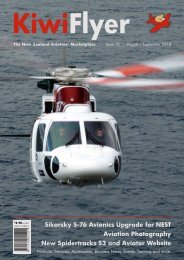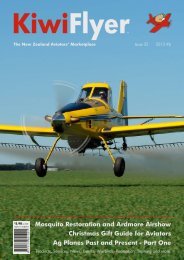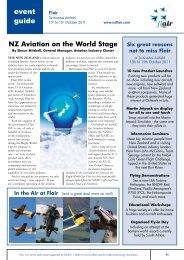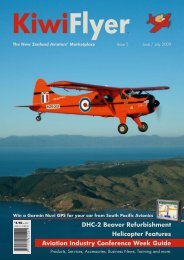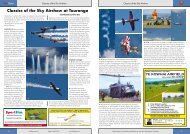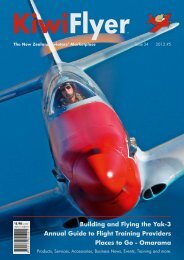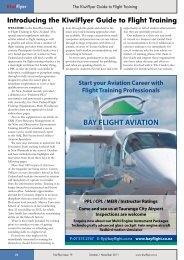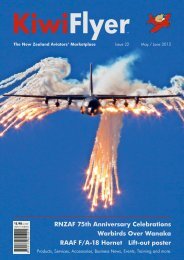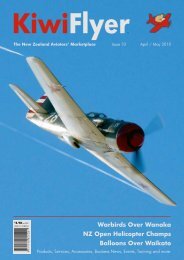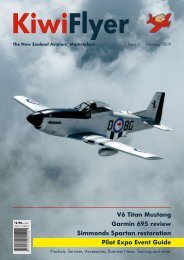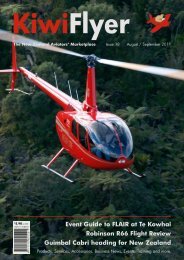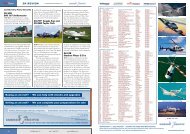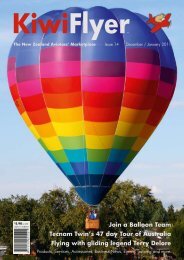Trans Tasman Furio Subsidised Aircraft Tracking Aero ... - KiwiFlyer
Trans Tasman Furio Subsidised Aircraft Tracking Aero ... - KiwiFlyer
Trans Tasman Furio Subsidised Aircraft Tracking Aero ... - KiwiFlyer
You also want an ePaper? Increase the reach of your titles
YUMPU automatically turns print PDFs into web optimized ePapers that Google loves.
<strong>KiwiFlyer</strong><br />
16 <strong>KiwiFlyer</strong> Issue 4 April / May 2009 www.kiwiflyer.co.nz<br />
Products and Services <strong>KiwiFlyer</strong> Business Profile<br />
Fabric covered aeroplanes are old, modern,<br />
beautiful and durable. But where does one turn for<br />
repair or restoration support? <strong>KiwiFlyer</strong> recently<br />
spoke with Paul Waterhouse of Central <strong>Aero</strong><br />
Engineering to help readers demystify the subject.<br />
WORKING WITH fabric covering<br />
systems does not involve witchcraft<br />
although not all maintenance organisations<br />
are equipped to handle major repairs.<br />
Most engineers have simply never dealt<br />
with it. As more LSA replicas come on<br />
line, the already large roll of fabric aircraft<br />
on the register is steadily increasing. A<br />
market niche is opening for the repair and<br />
maintenance of these aircraft and this is<br />
a niche that Hamilton based Central <strong>Aero</strong><br />
Engineering is keen to support.<br />
Central <strong>Aero</strong> Engineering Director,<br />
Paul Waterhouse has his focus on fabric<br />
covered aircraft operating within the<br />
central North Island and has identified a<br />
wide range within the Central <strong>Aero</strong> client<br />
base. The scope of aircraft stretches from<br />
classics, such as the Tiger Moth, through to<br />
regularly used Piper Cubs, the workhorse<br />
glider tug Pawnees and a plethora of<br />
recently arrived lightweight replica classics<br />
which come under the microlight category.<br />
Certified aircraft must be re-covered<br />
under the oversight of a LAME. Non<br />
certified aircraft and a number of those in<br />
the sport aircraft category can be ownerbuilder<br />
covered and repaired, although<br />
subsequent owners are permitted only to<br />
make simple repairs.<br />
Paul notes that Central <strong>Aero</strong><br />
Engineering are seeing a greater number<br />
of aircraft come through their doors<br />
with fabric components and a variety of<br />
finishing systems are being encountered.<br />
“We are keen and passionate about classic<br />
aircraft and enjoy working on them. Our<br />
own knowledge is strengthened by having<br />
Colin Sutherland of Rotorua available to<br />
carry out major fabric requirements.”<br />
Colin acquired his fabric skills on<br />
working agricultural aircraft such as the<br />
Piper Pawnee and has subsequently recovered<br />
a number of Tiger Moths, Austers<br />
and Cubs along with control surface recovers<br />
for various Harvards. Recently his<br />
expertise has been focused on sport aircraft<br />
types in the form of Pitts Specials.<br />
Material changes<br />
Traditionally fabric systems only dealt<br />
with Irish Linen and Grade A Cotton<br />
finished with either nitro-cellulose or<br />
<strong>Aircraft</strong> Fabric Spoken Here<br />
butyrate dope systems. The ubiquitous<br />
aluminium silver dope finish was the norm.<br />
Today, nitro-cellulose dope is a non starter<br />
although traditional silver and coloured<br />
dope finishes remain popular. Traditional<br />
linen and cotton fabrics are expensive and<br />
generally relegated to the purist market.<br />
The 1950’s saw the advancement of<br />
polyester heat-shrinkable fabrics which<br />
reduced the time required for installation<br />
because the fabric could be glued rather<br />
than sewn to the aircraft. Commonly<br />
known by the names Dacron,<br />
Ceconite or Stits, polyester<br />
fabrics have advantages in<br />
Colin Sutherland reinforces the wing tip area prior to<br />
applying further fill and finish coats of butyrate dope.<br />
that they are stronger than the natural<br />
fibres and are easier to work and less<br />
susceptible to fungal rot, although sunlight<br />
will deteriorate unprotected fibre. The<br />
finishing system is therefore all important.<br />
Increasingly, modern vinyl and polyester<br />
based finishing systems are replacing the<br />
traditional dope finishes and while no<br />
system will last forever a properly executed<br />
job should be good for 30 years or more.<br />
Fabric Assessment<br />
If the fabric on the aircraft is not factory<br />
original then the airframe logbook is the<br />
first place to look, although the entry may<br />
be lacking in detail. After determining that<br />
the fabric is a modern polyester, take a<br />
look at the coatings. Sunlight is the worst<br />
enemy of fabric and exposure to UV rays<br />
must be avoided. With dope based systems<br />
the coatings form a light-proof barrier<br />
against sunlight penetration. Look inside<br />
the fuselage which should be as dark as<br />
a cave. If you can see light then so can<br />
the fabric and that is a potential spot for<br />
<strong>KiwiFlyer</strong><br />
fabric deterioration. Polyurethane finishing<br />
systems put UV barriers in the coatings and<br />
let some light in but not UV rays through.<br />
Newer covering systems should be<br />
almost in perfect shape while a few repairs<br />
on older airframes are common. The upper<br />
surfaces of wings get the most exposure to<br />
sun, rain and other abuses and the finishing<br />
tapes can be prone to lifting. Cracks will<br />
be evident in the paint and may well have<br />
chipped off a sharp radius such as around<br />
door edges. These should be repaired<br />
with dope applied by brush. If<br />
you want a higher level of finish<br />
then sand it smooth and spray<br />
the dope on. A ding or tear may<br />
require a bit of glue, a fabric patch<br />
and some paint. Wingtips attract<br />
‘hangar rash’ and are often an area<br />
of constant repair.<br />
An all-dope finish is easy to<br />
repair. The main disadvantage with<br />
dope is the constant shrinking<br />
(even with non taughtening dope)<br />
that with time can cause cracking<br />
of the paint finish and even the bending of<br />
structural members. Polyurethane top coats<br />
on dope bring their own set of problems<br />
as the shrinking properties of the dope are<br />
at odds with the polyurethane’s less flexible<br />
finish and cracks are inevitable.<br />
Finishing Systems<br />
The subject of the various finishing<br />
systems is a whole article in itself. Colin<br />
Sutherland likes dope finishes as they are<br />
easy to repair. He feels comfortable with<br />
the technology but freely admits that it<br />
is time to give serious consideration to<br />
the likes of the Poly-Fibre and Stewart’s<br />
systems.<br />
Central <strong>Aero</strong> Maintenance see a future<br />
in offering fabric finishing system support<br />
and believe it is timely for newer aircraft<br />
engineers to embrace the technology<br />
available. “Someone has to be interested in<br />
these aircraft and we are,” says Paul.<br />
“Our facility has the potential to<br />
dedicate specific space to fabric repair<br />
and maintenance. Modern systems benefit<br />
from having a controlled environment for<br />
application and that is a path we are quite<br />
determined to pursue. Call us today to<br />
discuss your requirements.”<br />
Paul Waterhouse can be contacted on 07<br />
827 6488, email: paul@centralaero.co.nz or<br />
visit www.centralaero.co.nz<br />
<strong>KiwiFlyer</strong> can write a profile on your business. Call us on 0800 KFLYER to discuss options. 17


